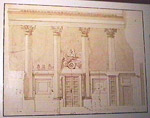Splendid Hall
Design of the Hall
The Old Hall of the House, as it appears today, is the second house chamber to occupy this space. The first hall, designed by Benjamin Henry Latrobe and constructed between 1803 and 1807, was gutted when invading British troops set fire to the Capitol in 1814. The surviving Hall was redesigned by Latrobe and completed by Charles Bulfinch between 1815 and 1819. It was first used in the year of its completion by the 16th Congress.
The Hall is an early example of Greek revival architecture in America. Latrobe adopted the shape and form of ancient amphitheaters for the new legislative chamber, with a lantern in the ceiling to admit light. In addition to the four fireplaces, Latrobe designed an ingenious central heating system to keep the Memberís warm.
The Splendid Hall did, however, have one infamous flaw. As Members addressed the House, the sound of their voices echoed through the chamber. The high, curving wooden ceiling created a cacophony. Every noise reverberated throughout the room, and conversations occurring across the room could be heard with alarming clarity, hampering the orderly conduct of business. Draperies were hung in the colonnade, and desks temporarily rearranged, but the acoustical problem continued. This, along with the need for additional space, helped motivate the construction of a new chamber in the 1857 Capital renovation. Later additions, including a fireproof cast ceiling (1901) and a marble floor (1864 -65) eliminated most echoes, but the strangest acoustical effects can still be demonstrated today.
Morseís House of Representatives
Samuel F.B. Morseís 1822 painting The House of Representatives, depicts the Members gathered for an evening session lit by an oil-burning chandelier. Here, Morse shows an unusually peaceful moment in the Chamber, emphasizing the harmonious, Classical architecture and the soft golden light of the chandelier. Morse used portrait studies for each individual shown in the work, including six Supreme Court justices, sixty-eight legislators, President James Monroe and the Chief of the Pawnee tribe. This mixture of the branches of government and the Native American leader furthers Morseís optimistic vision of national harmony. After Morse tried unsuccessfully to sell the painting to Congress for $1000, he abandoned his pursuit of a career as an artist and focused on his interest in science. Twenty-two years later, in 1844, Morse demonstrated his new invention, the telegraph, at the Capitol.
Morseís painting helped guide the recreation of the chandelier, sconces, and draperies during the partial restoration of the old Chamber in 1976.
Architectural Drawings
This drawing of the north wall for Benjamin Latrobeís reconstructed Hall shows the architectís design for the Car of History. Latrobe, born in England, was the first professionally trained architect and engineer to practice in America. Appointed surveyor of public buildings by Thomas Jefferson in 1803, he constructed and designed the interior of the House wing of the Capitol and rebuilt the Capitol after the 1814 fire.
Latrobeís Corinthian columns were modeled on the 4th century B.C. monument in Athens, shown at the right. The shafts of the columns in the Hall are made of a variegated breccia marble, quarried along the Potomac River. The columnís capitols are made from white marble carved in Carrara, Italy.

Colonnade of the House of Representatives, Benjamin Henry Latrobe, drawing, 1815 Photo Courtesy of the Library of Congress

House Chamber Seating Chart, engraving, 1845 Collection of the U.S. House of Representatives

The House of Representatives, Samuel F.B. Morse, oil on canvas, 1822 Corcoran Gallery of Art, Washington, D.C. Museum Purchase, Gallery Fund


